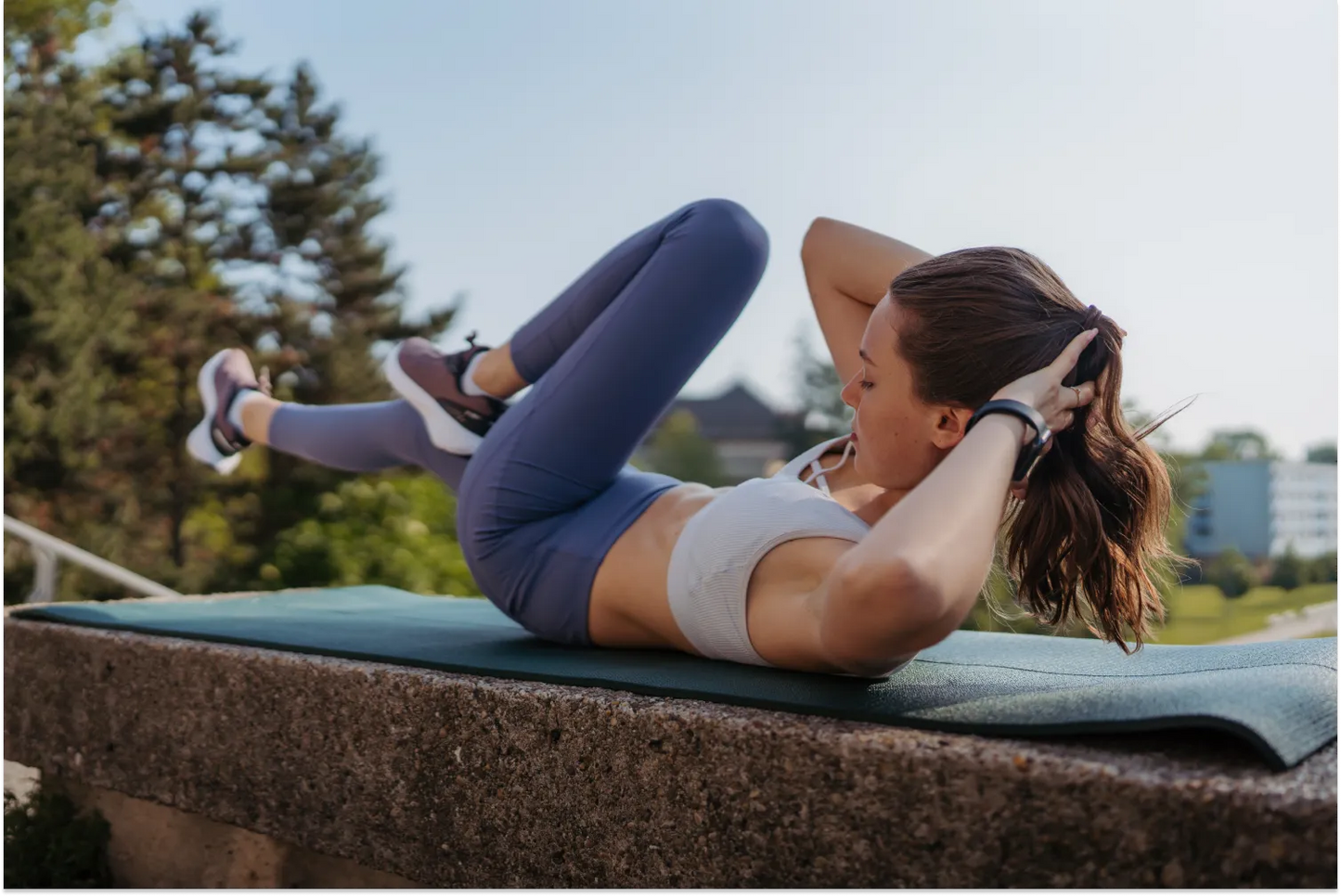
Embracing the journey to a more sculpted waistline is more than an aesthetic pursuit; it’s a commitment to holistic health and vitality. In a world where core strength symbolizes both physical prowess and inner resilience, the desire for a toned midsection intertwines with the need for a stable foundation.
Join us as we dive deep into core-enhancing exercises and understand why a powerful core extends beyond the mirror’s reflection.
Why Is a Strong Core Important?
While the look of a smaller waist can be quite alluring, the journey towards achieving it offers far better benefits. Let’s explore a few reasons below the surface for why you should pursue a stronger core:
- Postural integrity: A strong core helps us maintain an upright posture, which is important for our daily tasks. It helps keep those nagging backaches at bay and ensures that we carry ourselves with grace and strength, no matter our age.
- Movement efficiency: From the simple act of picking up a dropped pen to the complex dance steps that we might groove to on a Saturday night, our core is the silent worker behind all our movements. It ensures fluidity, power, and safety in our motions.
- Balance and stability: Have you ever wondered how tightrope walkers maintain their poise or how gymnasts pull off intricate flips? While practice is key, the foundation lies in a strong core, offering a stable base and making us less prone to injuries.
- Protection of internal organs: Like the protective walls of a fortress, our core muscles shield our precious internal organs, supporting them and ensuring they function seamlessly.
13 Exercises for a Smaller Waist
Getting a defined waist involves a mix of targeted workouts and dedication. Let’s dive into some of the most effective exercises tailored for this very journey.
1. Classic Plank
A foundational core-strengthening exercise, the plank is the cornerstone of many fitness routines. Originating from yoga and Pilates, this static hold engages not only the abdominals but also the shoulders, chest, and lower back, promoting endurance, stability, and a powerful core.
How to do it:
- Start by laying face down on the ground.
- Position your elbows under your shoulders, and prop yourself up into a push-up stance with your weight on your forearms.
- While inhaling deeply, keep a straight line from head to heels, ensuring your hips don’t sag or rise too high.
- Engage the core, squeezing the glutes, and hold the position for as long as possible without compromising form.
- As you advance, challenge yourself to hold it longer, aiming for increments of 10 to 15 seconds.
2. Russian Twists
A fusion of balance and rotation, Russian twists serve as an effective exercise for sculpting the waistline. By targeting the obliques, this exercise adds definition and challenges the rotational strength of your torso, which is pivotal in many daily movements.
How to do it:
- Find a comfortable spot on the ground and sit with your knees bent and feet flat.
- For added intensity, elevate your feet.
- Lean back slightly, ensuring your spine remains straight and not hunched.
- Clasp your hands or hold a weight, and with a controlled motion, rotate your torso, aiming to touch the ground beside you.
- Remember to exhale during the twist and inhale as you return to the center.
- Alternate sides, ensuring even reps on both sides.
3. Seated Barbell Twist
A lesser-known but highly effective exercise, the seated barbell twist introduces resistance to your core workout. By emphasizing oblique engagement, it builds muscular endurance and overall core strength, making functional tasks like lifting and turning more seamless.
How to do it:
- Sit tall on a sturdy bench, ensuring your feet are flat on the ground.
- Grasp a barbell or a broomstick and hold it behind your neck, across your shoulders.
- With your hips stationary, rotate your upper body to the left, feeling a stretch in your obliques.
- Return to the center and rotate to the right.
- Ensure the movement is controlled, avoiding jerky motions.
4. Bicycle Crunches
Bicycle crunches are the Swiss army knife of ab exercises. By combining the principles of crunches with leg movements, they provide a comprehensive workout for both upper and lower abs while introducing an element of cardio.
How to do it:
- Begin by laying flat on a mat, hands gently cradling your head.
- With your chin off your chest, elevate your legs, bending at the knees.
- Simulate a pedaling motion, bringing the left knee towards the chest while turning the right elbow to meet it.
- Exhale during the twist and inhale as you switch, alternating sides rhythmically.
5. Reverse Crunches
Traditional crunches predominantly focus on the upper abs. However, reverse crunches flip the script, emphasizing the often-neglected lower abdominals. This movement not only enhances core aesthetics but also fosters pelvic stability, which is important for balance and functional strength.
How to do it:
- Lay flat on a mat, arms resting beside you or under your hips for support.
- With knees bent, lift your legs so your thighs are perpendicular to the ground.
- Exhaling, push your heels towards the ceiling, lifting your hips slightly off the floor.
- Inhale as you slowly lower your legs without letting them touch the ground, maintaining tension in the lower abs.
6. Mountain Climbers
More than just a core exercise, mountain climbers are a full-body workout. By mimicking a climbing motion, this exercise combines the benefits of a plank with the dynamic movement of running, resulting in a heart-pumping, sweat-inducing workout.
How to do it:
- Start in a high plank or push-up position, hands under shoulders, and body forming a straight line from head to heel.
- Engaging your core and maintaining a neutral spine, rapidly draw your right knee towards your chest.
- As you push it back, draw your left knee forward.
- Continue this alternating motion as if “climbing.”
- Ensure a brisk pace and keep the core engaged, avoiding any sagging or piking of the hips.
- Aim for time intervals or set repetitions, progressively increasing as your endurance amplifies.
7. Hill Climber With Tuck
Taking mountain climbers up a notch, this variation introduces an explosive knee tuck, transforming a standard move into a high-intensity drill. It’s not just your core that gets a workout but also your lower body muscles and cardiovascular system.
How to do it:
- Begin in a strong plank position, hands aligned under the shoulders.
- Drawing from your core strength, bring one knee powerfully towards the chest.
- As you switch legs, tuck the incoming knee even closer, ensuring your back remains flat and your hips stay aligned.
- Focus on form over speed, but as you advance, aim to increase the pace while maintaining precision.
8. Pilates Scissor
Originating from Pilates, a discipline known for its emphasis on body alignment and core strength, the scissor move is a testament to controlled mobility. As the legs alternate in a rhythmic motion, the core and hip flexors are persistently engaged.
How to do it:
- Lay flat on your back, arms pressed by your sides for support.
- With a controlled motion, elevate both legs skyward.
- Using your hands, grasp one ankle or calf, gently pulling it towards you while the other leg is lowered slowly just above the floor.
- Ensure your lower back remains flat.
- Alternate legs in a smooth scissor motion, engaging the core throughout.
9. Pilates Criss Cross
Merging a crunch’s intensity with a twist’s rotational challenge, this Pilates exercise is core training at its finest. It targets the obliques and the central abdominal muscles, adding depth and definition.
How to do it:
- Start by lying down, hands cradling the back of your head to support the neck.
- Initiate a crunch, bringing one knee towards your chest.
- Simultaneously, rotate and connect the opposite elbow to the elevated knee.
- Maintain a rhythmic motion as you alternate sides, exhaling on each twist.
10. Side Plank Dips
A modification of the standard side plank, this movement adds dynamic dips, challenging the obliques and enhancing lateral strength.
How to do it:
- Assume a solid side plank position, supported by your elbow, feet stacked or staggered for stability.
- With your body in a straight line, lower your hips slightly towards the floor on one side.
- Engage your core to lift your hips back to a neutral position, making sure to engage your obliques.
- Repeat on the other side.
11. Standing Side Crunch
Transitioning core exercises to a standing position introduces balance challenges and engages stabilizing muscles. This move merges a leg abduction with an oblique crunch, offering both strength and coordination benefits.
How to do it:
- Stand up straight, hands lightly resting on your head or temples.
- With control, lift one leg out to the side while simultaneously crunching your torso toward the raised leg.
- Reset to the initial position, then switch sides, ensuring even reps for balance.
12. Brisk Walking
Often underestimated, brisk walking is a powerful full-body workout. By maintaining a faster pace, it bridges the gap between a leisurely stroll and a run, engaging muscles from the calves to the core.
How to do it:
- Stand tall, shoulders relaxed, and gaze forward.
- Engage your core, setting off at a brisk pace that noticeably increases your heart rate.
- Ensure your arms swing naturally, adding momentum.
- Maintain an upright posture, focusing on steady breathing and a consistent pace.
13. Interval Running
A cardiovascular powerhouse, interval running combines periods of high-intensity sprints with lower-intensity recovery phases. This approach not only maximizes calorie burn but also enhances stamina exponentially.
How to do it:
- After a thorough warm-up, start a sprint or high-intensity run for a predetermined duration, like 30 seconds.
- Once the sprint phase is complete, transition to a jog or walk, reducing the intensity for a recovery period, such as 60 seconds.
- This cycle — an intense burst followed by recovery — is one interval.
- Aim to complete multiple intervals, gradually increasing their number as your endurance improves.
- Always conclude with a cool-down and stretching session.
What Else Can Encourage a Smaller Waist?
While exercises specifically target and tone the muscles, the secret to a smaller waist is often found in the everyday choices we make. Adopting a holistic lifestyle that prioritizes overall wellness can do more than just slim your waist — it can also support your full-body health, too!
Here are some lifestyle changes you can make to encourage a smaller waist:
- Eat a balanced diet: Incorporating a balanced diet rich in whole foods, lean proteins, and beneficial fats supports metabolism and assists in managing weight.
- Get enough sleep: Often overlooked but deeply impactful, quality sleep is the silent healer. It supports muscle recovery, balances our hormones, and rejuvenates our bodies.
- Manage your stress: Chronic stress, if not managed, can lead to weight gain, especially around the waist. Embracing practices like meditation, deep breathing, or even a leisurely walk in nature can help keep the stress at bay.
The Bottom Line
Achieving a smaller waist requires dedication and patience. You’ll need to delicately balance various factors, including targeted exercises, conscious eating, rejuvenating rest, and a balanced state of mind.
During this journey, everyone carves their unique path, influenced by their body, environment, and goals. It’s essential to keep in mind that your path won’t be the same as someone else’s, and remember to celebrate every small achievement along the way.
Remember, it’s not just about the destination but the holistic, enriching journey towards it. For more health tips and products to help you along the way, follow along with Dr. Kellyann.
Sources:
Core Exercises: Why You Should Strengthen Your Core Muscles | Mayo Clinic
Low Back Pain | WHO
Core Stability Training for Injury Prevention | PMC
You Guessed It: Long-Term Stress Can Make You Gain Weight | Cleveland Clinic




